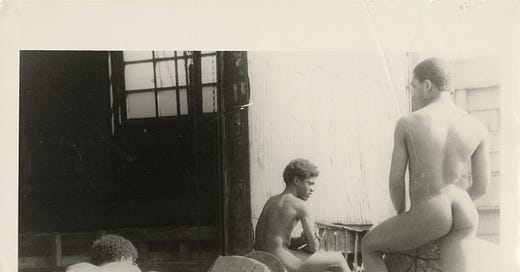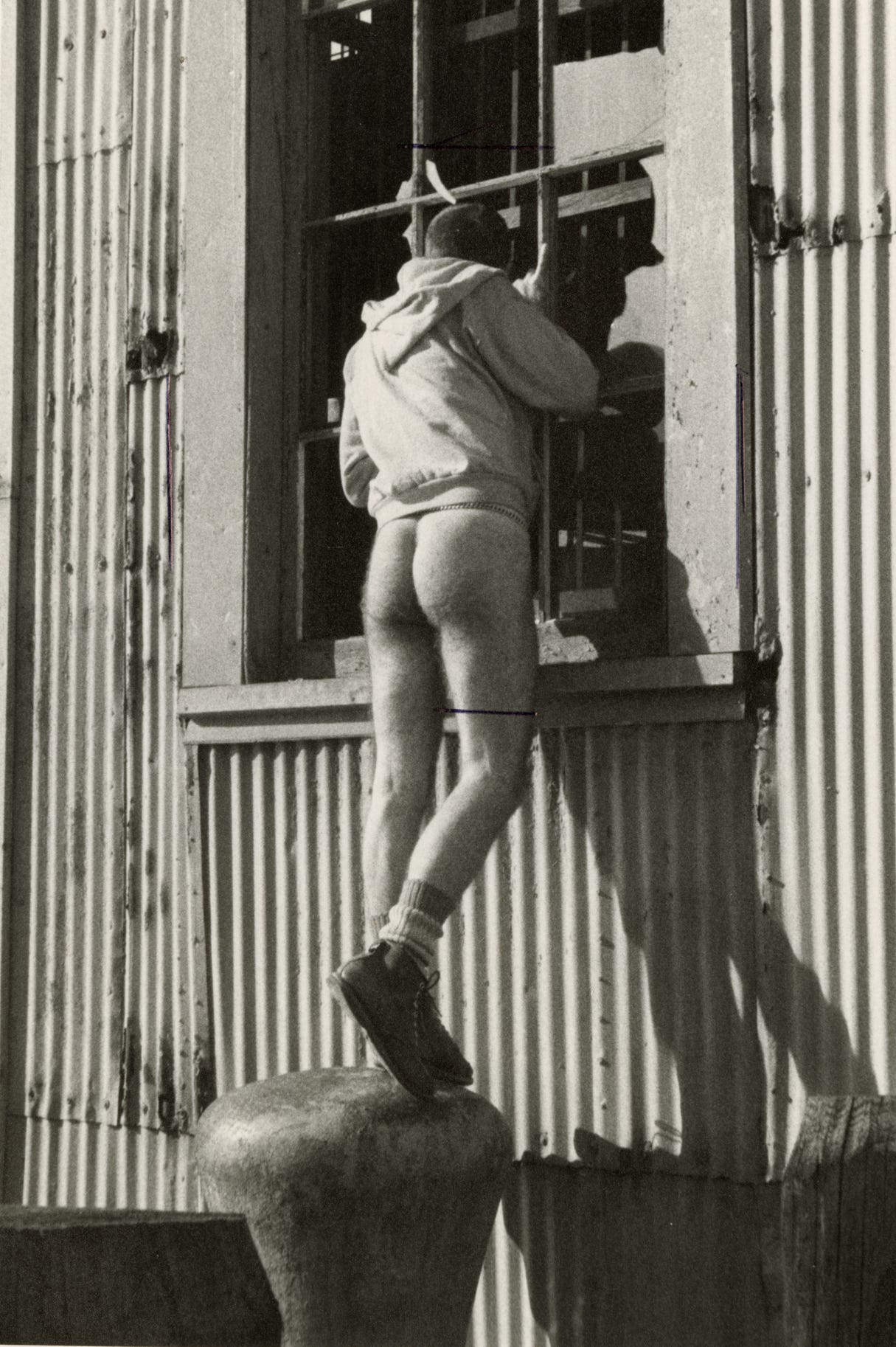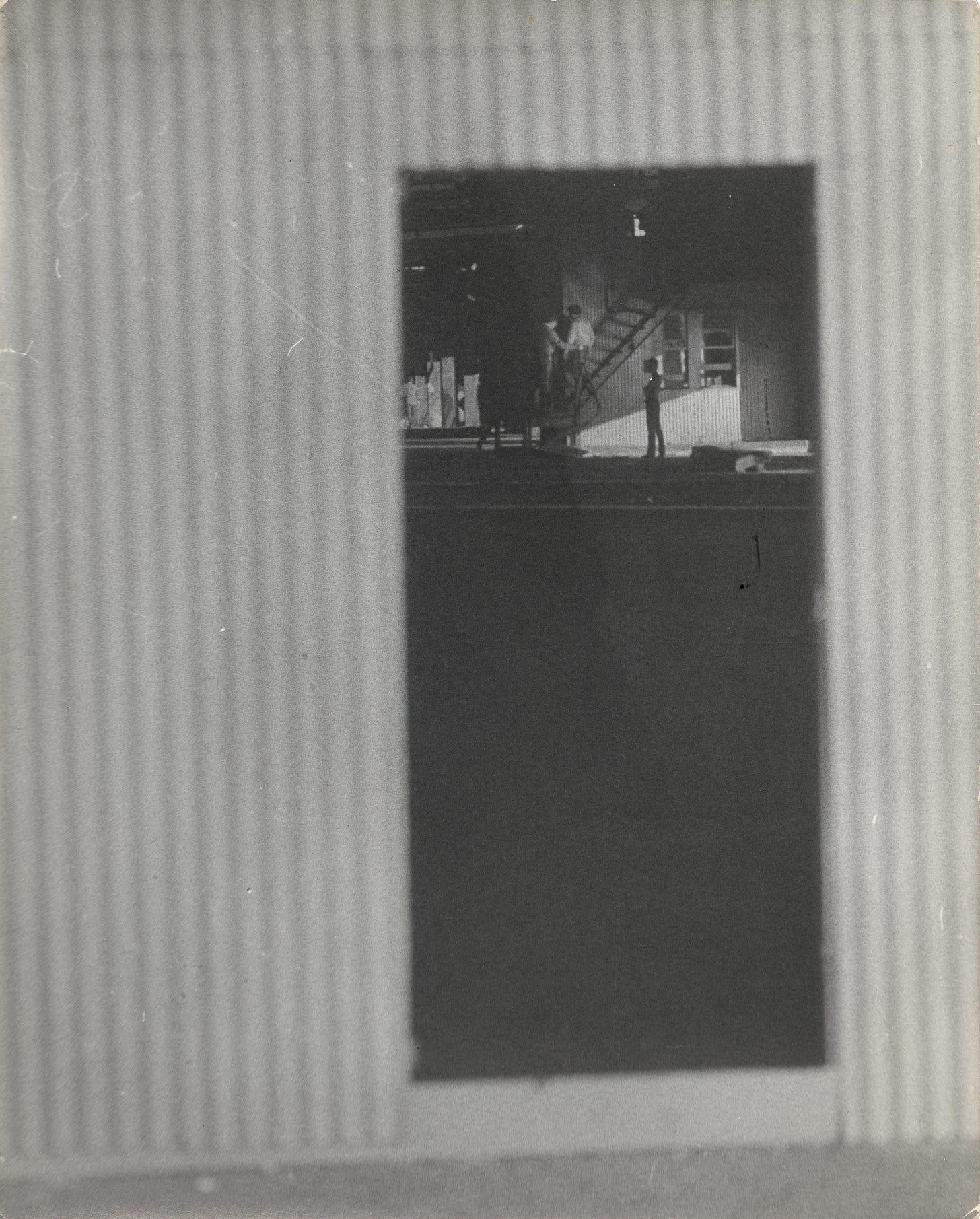Cruising Through Covid (lightly NSFW)
Alvin Baltrop at Hannah Hoffman Gallery, November 21, 2020 - January 23, 2021 Reviewed by Jonesy
Conversations about cruising1 are usually situated in the past, like it’s a specter that reminds us of a time before marriage equality and the ubiquitousness of hookup apps. There seems to be less cruising in the traditional sense now then there once was, and while there have been significant, noteworthy studies and essays discussing what the loss of these exchanges mean, Samuel Delany best defined the terms of cruising shifts and what he was feeling about the loss of the Times Square porn theaters in the 1990’s, when the Disneyfication of the Giuliani era obliterated the area’s seedy landscape beyond recognition.
In his book-length study and personal history of cruising Times Square Red, Times Square Blue, Delany wrote, “If every sexual encounter involves bringing someone to your house the general sexual activity in a city becomes anxiety filled, class bound and choosy. This is why parks, rest rooms, sex movies and bars with back rooms are necessary for a relaxed and friendly sexual atmosphere in a democratic metropolis”
I was thinking about this quote one day last year while walking through the cruising area of Elysian Park situated just outside downtown Los Angeles, where men find each other and hook up on various paths that overlook the city and the 110 freeway. I was scouting locations for a series of photographs I’m shooting for an upcoming show. I thought an active location like Elysian Park could provide the adrenaline I’m looking to capture in the staged photographs of groups of men I was constructing. It was thrilling to see the park’s paths filled with action, men masked and unmasked on the prowl for sex. It seemed the first spectacle of public virility I had witnessed since the pandemic hit, and the exhibitionist vibe was a turn on. I was eager to jump in, but entering a cruising site with a camera isn’t the best come-on so I walked around a bit digging the energy, then returned to my car in a blissed-out state at what I witnessed, knowing I’d be back soon.
I thought of the Delany quote again the next day as I walked through the Alvin Baltrop exhibition at Hannah Hoffman Gallery in Los Angeles. Alvin Baltrop was a photographer who quit his job and started a moving company, then lived in his van so he could be closer to the New York Piers2 he was obsessed with. He was hanging around and photographing the piers not strictly as a journalist but also as a participant. The 37 works in this show were in various forms of preservation. Purportedly, Baltrop set up a darkroom in the back of his van and printed on any paper available to him. That economy of means is well-preserved in this exhibition.
One photograph, The Piers (three men on dock) shows a group of young men naked together with their backs turned or in profile. Baltrop captures a composition here reminiscent of Greek statuary. And if we look below the surface of what might first appear to be journalism, we realize that the scene was possibly arranged or staged. It’s something about the proximity of the models to the photographer. It is with this kind of intimacy, that of a participant, that I react, as a cruiser, to Baltrop capturing the moments that soften the harder edge of cruising’s objectifying gaze.
In another image, The Piers (man squatting in warehouse), a man with his back to the camera looks out of a broken window frame while squatting in a state of waiting—a pose that’s indicative of cruising and part of what is referred to as the hunt. He’s got a t-shirt on but he’s naked from the waist down and he still wears his tube socks. His legs are spread showing off his cock and balls, and even though it doesn’t appear his clothes are nearby, there seems to be a readiness in his posture to quickly dress if needed. I imagine, given the other signifiers of what he’s wearing, that maybe he has gym shorts nearby that he can quickly get on if a threat arrives.
In a similar photograph, The Piers (man looking in window), we see a man naked from the waist down in just a hooded sweatshirt, socks, and work boots. On closer inspection, we notice a basic hardware store chain around his waist, an accentuation of the construction worker look. Although he’s turned away from us, we see he has closely cropped hair, one of the signifiers of the ’70s clone3. Again, there is an artifice to this photograph that feels slightly set up—although it is seemingly possible that Baltrop captured this man in semi-undress in the glaring sunlight exuding the newly found sexual freedoms of the time. I imagine he’s proud of his worked-out body and happy to show it off in this utopic setting of thrill and danger. The photographs in the show mirror much of what the sex clubs and the clone bars of the era sought to imitate with a rundown vibe indicative of the forgotten parts of the city where men meet for sex. In this way they reflect the life outside back into the bars, staging a recreation that heightens the psychology and obsessiveness of the cruising experience.
In The Piers (figures in warehouse) Baltrop looks through a doorway cut into galvanized metal at a group of five men. Two are flanked by a watching group of three on an old scaffold, ladder, or staircase. One of the standing duo has an arm casually draped over the other standing man, who is getting head from a squatting man. Cruisers will recognize this familiar maneuvering as a way to shield a scene or create a kind of makeshift privacy for participants who shut out others in the heat of having found their trick. The isolated figure closest to us has their arms crossed in a pose of what looks like frustration over being left out. The other figure is in motion, walking toward the active scene, possibly in an attempt to join or get his turn after. This photograph has no hints of artifice; it is caught in that instant other documentary photographers have referred to as the decisive moment (even though I don’t suppose any of the more famous street photographers would have viewed Baltrop’s cruising scenes as things worth capturing).
In The Piers (parking lot) six very different cars line up in a dark parking lot alongside the river. Whether or not Baltrop intended it, the cars reflect a variety of tricks as we imagine the stereotypes of the men that drive each of them. It’s also a very familiar scene to any cruiser to recognize clumps of cars as a potential site for where the action is happening. The photo is shot from above—maybe Baltrop is where the current action is going on and the photo is a way for him to remember a certain trick’s car. A familiar tactic for anyone who cruises regularly is to take into account and remember the vehicles and whom they belong to. This recognition can produce an added thrill the next time one enters a cruising area and sees the trick’s car and knows they can be found there.
The photographs in the show all convey different sensations of the cruiser’s experience. Seeing them added an additional impact to the memories of my cruise the day before in Elysian Park. One might guess that the current uptick in cruising in the park is in response to the Covid-19 pandemic. While walking through the Alvin Baltrop exhibition, where one was reminded of the danger present to the men who frequented the piers, I couldn’t help but make the connection to Elysian Park, where contact is made even more risky not just by the threat of law enforcement but by the pandemic and the information about transmission we’re weeding through daily as we make personal choices as to which boundaries we are each setting for contact with others.
As with the experiences of Delany and Baltrop, the cruisers in Elysian Park are predominantly men of color, Latino and Latinx men who represent the main demographic of the nearby neighborhoods. These are traditional working-class neighborhoods, but that’s rapidly changing due to gentrification. Most of these places are heavily populated, which can make it more difficult to bring people home, rendering public sex an option one might be compelled to choose due to family situations or roommates. Also, due to Covid safety rules, the seemingly less risky choice of having sex outside could contribute to the surge in activity I’ve seen in the park since pre-Covid times. I had all about written off parks as places to cruise years ago. So for me, there’s a thrill in seeing these places returned to their former glory as spaces of chance, thrill, danger, resistance, and brotherhood. The current situation has given way for these older forms of cruising that have an authenticity not available in the virtual sphere, where an app can have the effect of a made-to-order sex experience similar to online shopping—and that’s not meant to denigrate the online experience. It has many more benefits than potential grievances. But it has taken away the possibility of meeting someone you weren’t at all looking for, which the physical cruising space offers. There are examples where cruising has found a way to merge with the digital domain for another sort of experience that combines both worlds. Sniffies is a site that has an interactive public sex map built into it, which recalls the early days of online cruising on sites like cruisingforsex. It’s been a very popular option for men looking for public sex during the pandemic. Under its “Places” menu it lists Elysian Park as a popular spot and gives the data on how many men are currently there, how many were there earlier that day, and the amount that have been there during the week. The app tells one where to go to find sex and how to avoid possible entanglements with police or park-goers. It also has a GPS that allows you to see where users are. You can even leave private messages for one another. Perhaps with these combinations of digital and analogue cruising, we will create new forms that blend the two experiences into something that yields new energies and exchanges we hadn’t previously imagined, collapsing cruising’s history and its future together into some new mind-bending experience where the ghosts of Baltrop’s cruisers mingle with the heirs of their legacy.
Jonesy is an artist living in Los Angeles. He studied photography and video at Tyler School of Art in Philadelphia, PA. In the 1990s, he was a member of the queercore band Fagbash in San Francisco, which continues to inform his aesthetic. Since 2008 he has been creating photography, films, installations, and performances which have been shown internationally. Find him @jonesyfilms23 on Instagram.
Cruising is walking or driving about a locality, called a cruising ground, in search of a sex partner, usually of the anonymous, casual, one-time variety.
In the ’70s and part of the ’80s the abandoned piers lining the Hudson River in Lower Manhattan became the loci of public sex for some of the city’s gay population (as well as improvised art galleries for a select group of the city’s artists). These historical sites have long since been demolished.
“Clone” is slang for a homosexual man who appeared in dress and style as an idealized working-class guy. The clone appearance typically consisted of closely cropped hair and masculine attire such as uniforms, leather, or Levi's.







